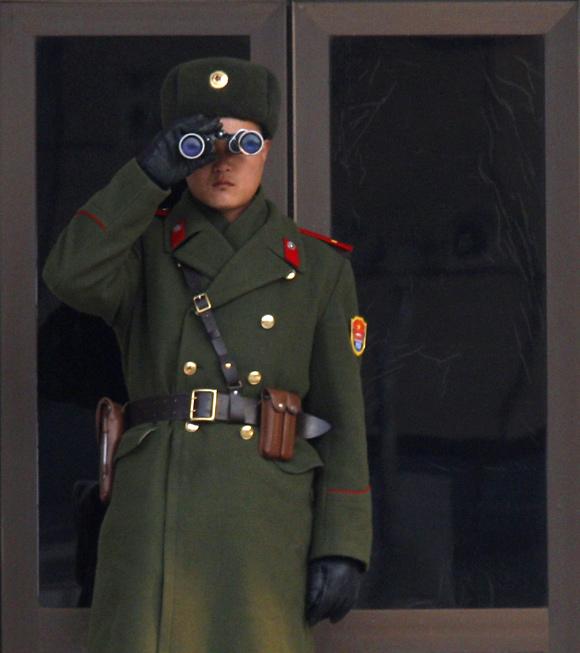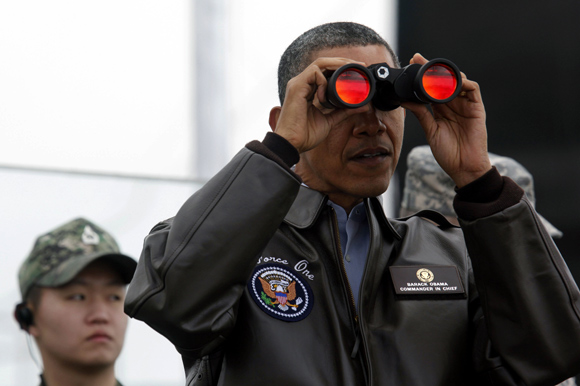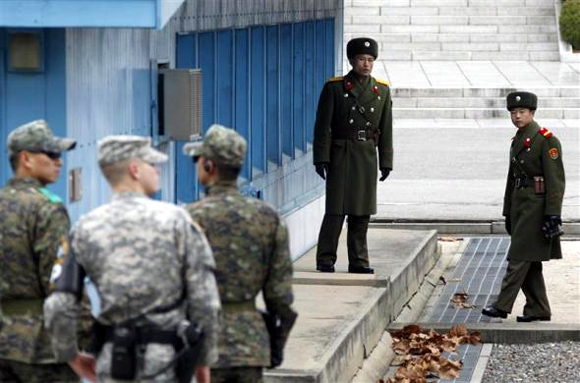
Unlike Wagah, where India and Pakistan mount an elaborate daily drama of military ritual watched by tourists on both sides, the Demilitarized Zone, which separates North and South Korea is barren and desolate, a terrain bristling with hostility, discovers Nikhil Lakshman.
A day after his encounter with Barack Obama, United States Army Private First Class Andrew Wilson shrugs when reporters ask him about his meeting with his President.Wilson, a 31-year-old former machinist from the steel town of Pittsburgh, Pennsylvania, conducts tours for visiting leaders, nosy journalists and other touring parties at the Demilitarized Zone, which separates North and South Korea.
Unlike Wagah, where India and Pakistan mount an elaborate daily drama of military ritual watched by tourists on both sides, the DMZ is barren and desolate, a terrain bristling with hostility, where South Korean, American and other nations' soldiers are separated from their North Korean counterparts in one area by just a narrow strip of road.
Wilson and his colleague Private Guerra, a stocky Hispanic from California who turns 28 on Wednesday, tell reporters not to make any contact with the North Koreans when we see them. No pointing. No waving out to them. And, yes, absolutely no verbal contact!
As we stand outside Freedom House -- the grand building which the South Koreans built to encourage families from both Koreas separated by the Korean War to meet, something which never materialised since the Kim dynasty was averse to the prospect -- a North Korean soldier watches us carefully with his binoculars from the building across Freedom House, less than 300 feet away.
He looks at the group of Indian reporters with what we believe is curiosity; it is not every day that women in colourful salwar kameezes turn up at the DMZ. Then, the North Korean turns away. Not for us the brazen show of disrespect when George W Bush and then South Korean president Kim Dae-jung visited the DMZ in 2002. One North Korean soldier then polished his shoes with an American flag while another blew his nose into a South Korean flag.
...

The fourth American president (Ronald Reagan, Bill Clinton and Bush were the others) to visit the DMZ, truly the last frontier for the Cold War, Obama spent two hours with American soldiers at Observation Post Ouellette after dropping in at Camp Bonifas, the first halt for all visitors to the DMZ.
It was at Bonifas that he ran into PFC Wilson, asking the soldier where he hailed from, then asking if he was a fan of the Steelers, Pittsburgh's famous football team. "I told the President 'I hate them'," Wilson recounts a day later.
"Oh, Mr Wilson, that's why they kicked you out of Pittsburgh," Obama responded with a grin. "No sir, I like Heinz," Wilson replied. "Heinz?" the president asked, clearly puzzled. The ketchup company, Wilson clarified, not looking forward to the footage of this encounter being aired on American television and being woken up in the middle of the night by his pleased mom and grandmother, like it has happened six times before.
...

Then there is the Peace Village or Kijong-dong village which the North Koreans built as a model rural commune. Only it seems a scene out of the Jim Carrey film The Truman Story, where doors and windows have been painted on empty shells of buildings, the Americans claim, but no residents have been spotted. Loudspeakers in the village used to broadcast North Korean propaganda loudly into the DMZ all night. Then, abruptly, in 2004, it stopped.
Then, there is a United Nations checkpost where we are surrounded by North Korea on three sides. Below us is the Bridge of No Return where prisoners in the Korean war of 1950 to 1953 were given a choice of either staying with their captors or returning home.
For 15 years thereafter, the bridge was used to exchange prisoners but later felt into disuse, only for its likeness to surface in movies like the James Bond movie Die Another Day and Angelina Jolie's recent thriller Salt.
"People don't believe this is the Bridge of No Return," Wilson tells us. "There was this lady visiting recently who said 'That is not the Bridge of No Return!' I said, 'It is, Ma'am.' 'You are lying, that is not what I saw in the movies,' she said. 'Maybe, Hollywood is lying, Ma'am,' I said, 'after which she didn't speak to me anymore."
...

One villager stayed 239 nights last year and was booted out of the village by the South Korean government, Wilson tells us. The villagers have also to be home by nightfall and to lock all their doors and windows by midnight.
The villagers farm rice and soya beans, but make almost five times the money other South Korean farmers earn for sowing the same crops; the South Korean government pays the Tae Sung Dong farmers $82,000 a year for their crops.
Wilson and other American soldiers travel to Tae Sung Dong every week to teach the kids in the village English. Inevitably, the lessons are replaced by games of soccer.
Andrew Wilson says he is getting tired of getting his butt kicked in these games regularly by the eight year olds. When his tenure in the DMZ ends, he has requested a transfer to Afghanistan.
Click on NEXT for more...